Plums are extremely popular and no wonder, when they taste so great! These sweet fruits grown on small trees or shrubs, which produce white flowers. There are several different types of plums and they all have one thing in common—they have pits.
Connect with a verified veterinarian in minutes. Licensed vets are available 24/7 to answer your questions. No need to worry about your furry family member.
Plum Pits are Toxic for Dogs
Plums contain one large seed, which is called a pit. The pit contains several toxic substances including:
- Hydrogen cyanide
- Amygdalin
- Prunasin
- Cyanogen
These substances can create cyanide, which is a highly poisonous substance to dogs and humans. When a plum pit is eaten whole, the acids in the stomach and digestive tract dissolve the pit, which then releases these toxins into the body by way of the bloodstream. This works to spread the toxins throughout the dog’s body. Another way for toxins to be released and spread is if the dog has chewed up the pit.
Symptoms of Plum Poisoning in Dogs
If your dog has eaten a plum pit, then you may notice these symptoms:
- Seizures
- Agitation
- Foaming at the mouth
- Collapse
- Shock
- Breathing difficulties
- Tremors
- Convulsions
- Red gums, tongue, and mouth
- Dilated pupils
- Collapse
- Death
If your dog has eaten a plum pit, or you suspect he’s done so, then call the vet immediately. This is a medical emergency.

Review symptoms, medications & behavior to keep your pets healthy with a Vet Online in just minutes.
Ask a Vet Live NowIntestinal Blockage from Plum Pits
If a dog eats too many plums and pits, it’s possible he could develop intestinal blockage, which can be a life-threatening condition. The symptoms of this condition include:
- Vomiting
- Constipation
- Loss of appetite
- Weakness
- Nausea
- Diarrhea
- Abdominal pain & swelling
If you notice these or other concerning symptoms in your dog, call the vet immediately. This could be an emergency.
Other Ways for Dogs to Become Poisoned by Plums
Plums can be easy for a dog to access, as the trees and shrubs that produce these yummy fruits may be growing in your backyard or neighborhood. Dogs may also access plums or plum seeds in the house. For instance, if a bowl of plums is left on the counter or table, a dog could jump for them and eat them off the floor!
There are also other ways for a dog to become poisoned by plums. A dog could eat plum branches and leaves or even the roots of the plant. These can also cause plum poisoning if eaten in large enough amounts. Plum plant parts can cause digestive system irritation or even breathing difficulties if eaten.
The plant and the fruit contain other substances in addition to cyanide, including amygdalin, prunasin, and cyanogen. These substances can cause many of the same symptoms as the cyanide found in the plum’s pit.
What Types of Plums Can Cause Toxicity in Dogs?
Plums belong to the Prunus genus and the Rosaceae family. The most common plants are the Prunus domestica and Prunus Americana. But there are also some subspecies in the plum family that are toxic to dogs, including:
- Imperial gage
- Damson
- Yellow egg
- Blue rock
- Maynard
- Jefferson
- Lombard
- Czar
Diagnosis & Treatment of Plum Poisoning
You’ll need to get your fur baby to the vet immediately because cyanide is a fast-acting poison that can lead to death very quickly. When you reach the vet, they will begin with a physical exam. The vet may check your dog’s gums first to see if they’re bright red or pink from the cyanide.
The vet will also perform a physical exam and order lab tests that may include CBC, blood urea nitrogen, packed cell volume, and more.
Treatment will begin very soon before test result even show up. This is because of the high toxicity of cyanide. The vet will work to detoxify your dog’s system through medications that may include sodium nitrite or methylene blue. If these don’t work, the vet may choose to use thiosulfate. These medications work to remove cyanide from the system.
Your canine companion will need to stay in the hospital for one or two days to be monitored.
Recovery is will depend on the number of plum pits the dog’s eaten, and how soon he received treatment. If your dog is treated quickly, then he has a better chance to go on to a complete recovery.
So, it’s best not to allow your dog to have access to plums. You can give him some of the fruit, but only a little bit (because it contains high amounts of sugar). Just be sure to remove the pit first and keep all plum pits where your dog can’t get to them.
Connect with a verified veterinarian in minutes. Licensed vets are available 24/7 to answer your questions. No need to worry about your furry family member.

Julie
Julie is a graduate of the University of North Carolina, Wilmington, where she studied Animal science. Though contrary to the opinion of her parents she was meant to study pharmacy, but she was in love with animals especially cats. Julie currently works in an animal research institute (NGO) in California and loves spending quality time with her little cat. She has the passion for making research about animals, how they survive, their way of life among others and publishes it. Julie is also happily married with two kids.
Review symptoms, medications & behavior to keep your pets healthy with a Vet Online in just minutes.
Ask a Vet Live Now




